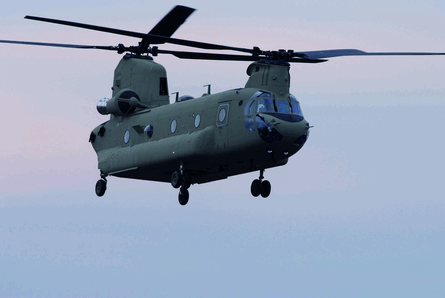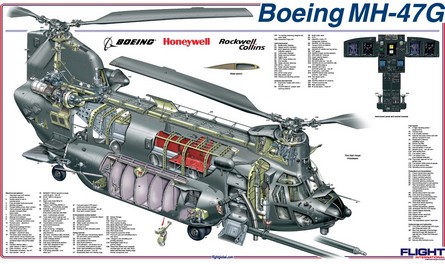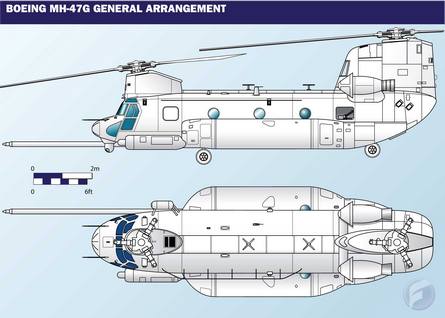What began as another remanufacture of the US Army's long-serving CH-47 Chinooks has evolved into a programme that will keep the heavylift helicopter in production beyond 2018 - and in service beyond 2030.
 |
|---|
© Boeing |
The renewal of the Chinook coincides with a renaissance of the helicopter in the aerial assault role it performed in the Vietnam War. Because of its size, the CH-47 had been reassigned to logistics missions behind the line, but the superior hot and high performance provided by its tandem rotors has made the helicopter essential to combat operations in Afghanistan.
"The CH-47F is out in the front line performing aerial assault, with a fully digital glass cockpit, networked communications and state of the art aircraft survivability equipment," says programme manager Ken Eland. The special-operations version, the MH-47G, was first deployed to Afghanistan in February 2007, followed by the regular army's F model.
These helicopters are the first of a planned 452 CH-47Fs for the US Army and 61 MH-47Gs for the army's 160th Special Operations Aviation Regiment (Airborne). They are being produced under what began as the Improved Cargo Helicopter programme. This was intended to remanufacture the Chinooks to restore their life and increase their capability. At the same time as the regular army's D models were upgraded to Fs, the special operations E models were to be rebuilt as Gs.
Because of changes to the timing and scope of the programme, the CH-47Fs now rolling off the Boeing assembly line in Philadelphia, Pennsylvania are more capable machines than originally envisaged. "The F and the G were part of the same acquisition plan," says Eland. "The Gs were to be interspersed between the Fs, but then the army decided to stand up the Gs early. That gave us an opportunity to make many changes to the F."
Boeing built three CH-47Fs - two development and one low-rate initial production aircraft, the first flying in June 2001 - then switched to producing the MH-47Gs. Because Special Operations Command is both replacing attrition and increasing its fleet, the 61 G models will be a mix of remanufacturedMH-47Es and CH-47Ds.
The company looked at the gap in production as an opportunity to see what it could do with the F model. "When we went into solely G production, we took every block improvement we could into the F," Eland says. These included new airframe, digital automatic flight controls and a fully glass cockpit.
The biggest change was to introduce a cockpit based on the Common Avionics Architecture System (CAAS) originally developed for retrofitting into Special Operations Command helicopters. "They were working with Rockwell Collins to develop a common cockpit at SOCOM. We took that into the G and then used the G as the foundation for the F."
The original plan for the CH-47F was to upgrade the D model to a partial glass cockpit, with four displays and moving map, butretaining engine and other instruments.Developed by Rockwell Collins, the fully glass CAAS cockpit combines flight information, engine instruments and crew alerts on five larger liquid-crystal displays.
"The G accelerated the incorporation of CAAS onto the F," says Eland. "That avoided a big retrofit and gave us a common cockpit from the get-go. We put CAAS into the LRIP aircraft as a risk reduction, and used it for training." The plan now is to keep the hardware and software in the F and G models as common as possible. "We are working hard to maintain the same hardware level and as much software commonality as possible," he says. The CAAS software is partitioned, so new functionality can be added as plug-and-play modules without the complete system having to be revalidated (see box P45).
The CH-47F goes beyond the G, introducing the BAE Systems digital advanced flight control system (DAFCS) and integrating it into CAAS. "There is an embedded flight director in CAAS that is fully coupled to DAFCS," says Eland. The DAFCS is also integrated with the CAAS flight management system and can fly the aircraft from take-off through to hover. Replacing the existing analogue system, the DAFCS increases reliability and has built-in diagnostics to improve maintainability.
Other aircraft systems are essentially unchanged. Drive systems removed from D models are sent for "super overhaul" and emerge with "near-zero time" on the components, says Eland. The CH-47F uses the Honeywell T55-714A engine that is already replacing the -712 in the CH-47D fleet. The more-powerful -714A maintains the -712's sea-level power rating of 3,750shp (2,790kW) to 4,000ft (1,200m) and 35e_SDgrC (95e_SDgrF), providing a significant increase in hot-and-high performance.
The original plan to refurbish the CH-47D airframes was changed as it became more cost-effective to manufacture new airframe sections. Boeing is also building all-new CH-47Fs to top up the army's Chinook fleet, and soon for export customers. At the same time, the special operations MH-47Gs are all being remanufactured.
The Philadelphia assembly line, therefore, is producing new, "renew" and "reman" Chinooks simultaneously. This is possible, Eland says, because the CH-47 airframe incorporates true manufacturing splices. "You can take one piece off and put on another. One aircraft we called Mr Potato Head was put together from spare aft fuselage, cabin and cockpit."
The process begins by flying in a CH-47D or MH-47E, stripping it, taking the cockpit off, and removing the rotors and dynamic system and sending them for overhaul. "To produce a G, we take the aft fuselage and cabin, media-blast strip it to bare metal, inspect and repair." A new cockpit is then spliced on. "We bolt it right up to the D/E cabin - repeatably."
Tightly Controlled Interfaces
Although the cockpit is produced using three-dimensional digital design tools, and the cabin was built using traditional two-dimensional mylar drawings, the manufacturing splices provide tightly controlled interfaces between the cockpit, cabin, aft fuselage and rotor pylons. "We can take the cockpit off an aircraft built in 1970, build a new cockpit and splice it on repeatably," says Eland.
All the Fs, meanwhile, will have new airframes, whether they are "new" or "renew" aircraft. The only parts of a D airframe that are reused are the fuel pods, tunnel covers and other pieces that are not maintenance drivers. "The things we keep today are 10-20% the cost of new. When we get to two-thirds of the cost we convert to new," he says.
The new airframe sections make increased use of machined parts and integrated features to make assembly easier. "We have reduced parts count by 35% and fastener count by 35% and have much more repeatable assembly," he says.
As well as the redesign, the cost of a new airframe has been brought down through "right-sourcing", says Eland. "We used to make every part. Now we have outsourced the detail parts and focused in on final assembly. We bring in significant subassemblies to asingle pulsed moving line."
Boeing's Macon, Georgia plant makes the new aft fuselages, while L-3 Crestview in Florida produces the new cabins. Even the disassembly of incoming Ds and Es has been outsourced, to a small company in Delaware, which supplies stripped cabin and aft fuselages to the Boeing line.
Whether newly built and spliced or stripped and repaired, the cabin/aft fuselages arrive on the same moving assembly line in Philadelphia, where they are mated to new-build cockpits. "They are identical, independent of their source," says Eland.
Extensive Mission Equipment
Whether it's a new or renew CH-47F or a remanufactured MH-47G, the assembly work is also largley the same. The wiring and avionics backbone are identical and while the special-operations G model has unique and extensive mission equipment, it is installed by the customer after delivery, which helps balance the work content on the assembly line.
But with F production ramping up as Gs continue to be built, Eland says it is a challenge on a single pulsed line to manage the manpower at different assembly positions. So Boeing plans some changes this year, including creating a spur line to do the additional work required on a G airframe.
Changes are needed because the first aircraft for international customers will soon be added to the line. Jigs were loaded in February for the first of six helicopters for the Royal Netherlands Air Force. These are new-build F models, but with a Honeywell glass cockpit. Despite this "they are more similar than the F and the G", he says.
A contract is expected to be signed with Canada by year end for 16 new-build helicopters. These are expected to be a unique configuration combining features of the F and the G, although Canada is negotiating for accelerated delivery of an initial six aircraft by taking US Army-standard CH-47Fs straight off the assembly line. These are urgently needed for operations in Afghanistan.
Boeing has the capacity to produce 50-60 new, renew and remanufactured Chinooks a year, and delivered 36 in 2007. In addition to the new aircraft for the Netherlands and Canada, several countries are expected to remanufacture their CH-47s or buy new-build F models. Boeing has previously listed India, Pakistan and Saudi Arabia as potential customers.
Boeing has signed a memorandum of understanding with AgustaWestland to offer the CH-47F to the Italian army, which operates CH-47Cs. Remanufacturing a C model to F standard is possible, but little can be reused as a new drive system is required, says Boeing. The Netherlands has said it also wants to upgrade its 11 existing Chinooks.
As for future upgrades, Eland says Boeing "cleaned the slate on the F model", ultimately putting everything on the platform that was at an appropriate technology readiness level and ready to go. "We are now working with the US Army to work out what the next capabilities will be for a growth Chinook," he says.
Eland says the focus will be on the short-term ability to drive additional performance into the platform. "We will continue to evolve the information exchange capability. We have a very expandable cockpit." He also expects to see performance growth from the existing Chinook drive system through improved rotor blade aerodynamics.
Beyond that there will be an effort to identify the next big evolution of the Chinook, including new rotors and cabin lengths, he says. Boeing has already studied a much larger tandem-rotor helicopter under the US Army-led Joint Heavy Lift concept development effort.
But with a large tilt-rotor the army's current favourite for JHL, the Chinook could remain the premier tandem-rotor heavylift helicopter for another two decades.
|
|
|---|
Specifications | |
|---|---|
| Length - fuselage | 15.9m (52ft) |
| Length including rotors | 30.2m (99ft) |
| Width | 3.78m (12.4ft) |
| Rotor diamater | 18.3m (60ft) |
| Height | 5.77m (18.9ft) |
| Propulsion | 2x Honeywell T55-GA-714A Engines |
| Speed | 287 km/h (155kt) |
| Fuel | 3,910 litres (1,034 US gal) |
| Service ceiling | 6,100m (20,000ft) |
| Useful load | 10,900kg (24,000lbs) |
| Max gorss weight | 22,700kg (50,000lbs) |
| Mission radius | 370km (200nm) |
'22088' |
|---|
Source: Flight International

















